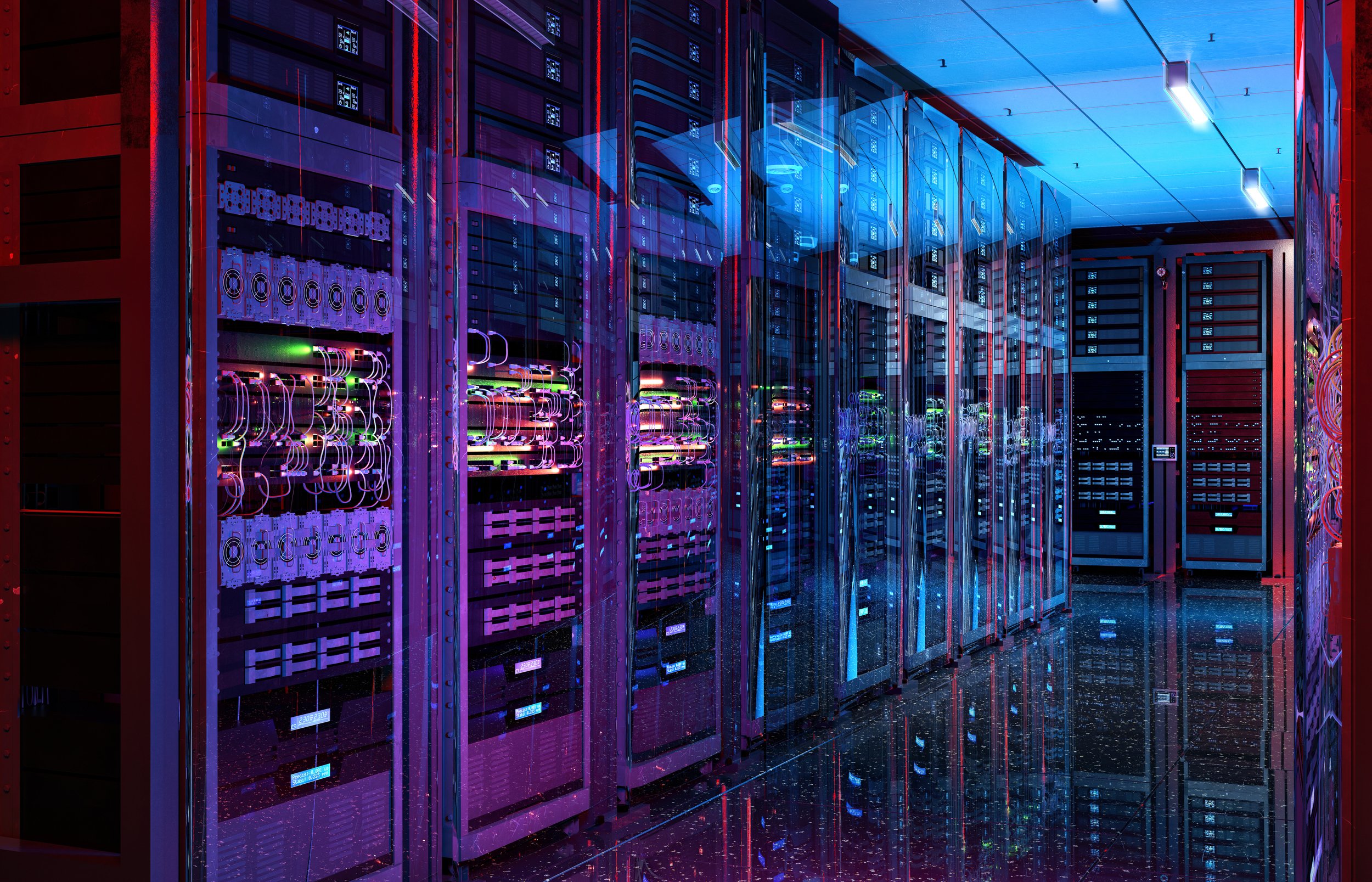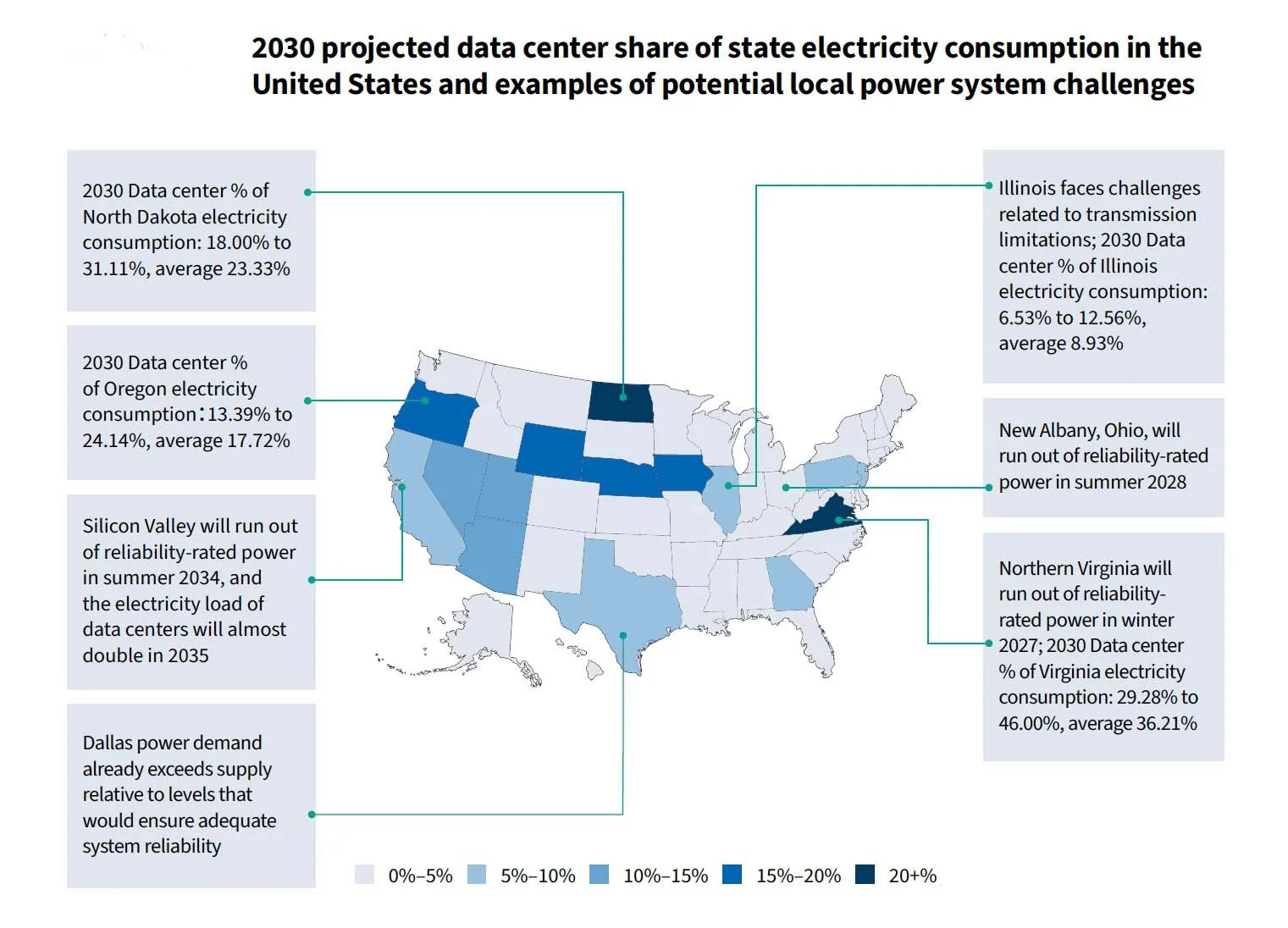
Data Centers and the Environment
The Rapid Growth of Data Centers
Data centers are under increasing pressure to reduce their carbon footprint due to concerns over climate change. While data centers have been part of our economy for decades, the landscape changed significantly starting in the 1990s with the evolution of microprocessors and client/server computer models. Different types of data centers can power core economic development needs such as cloud computing and emerging technologies like artificial intelligence—and they can also power less vital services such as Bitcoin/Cryptocurrency mining, which can use massive amounts of energy (despite less energy-hungry alternatives) and creates few jobs. The rapid expansion of these digital technologies come with a significant environmental cost due to the immense energy consumption required to operate 24/7.
The challenge with the rapid proliferation of data centers is the impact on energy demands in.a very short period of time. The most significant concern with this imbalance is the potential to create instability in the electricity grid.
According to the IEA, U.S. data center electricity consumption is expected to grow at a rapid pace in the coming years, increasing from around 200 TWh in 2022 (~4% of US electricity demand), to almost 260 TWh in 2026 to account for 6% of total electricity demand, with 33% of global data centers located in the U.S.
Data centers will account for up to 12 percent of all U.S. electricity consumption by 2028, or 132 gigawatts annually, triple what they consumed in 2023, according to a December 2024 analysis by Lawrence Berkeley National Laboratory. That’s roughly equivalent to the annual power demand of Norway or Sweden.
However, certain “Hyper Scale” data centers are also driving the demand for clean power that can operate 24/7 due to their climate commitments. For example, Google has announced its plan to procure clean energy around the clock by 2030 on every grid where it operates. And Microsoft has committed to becoming carbon-negative by 2030, with green power for all its data centers.
In Kentucky, Power Engineering Magazine reported in October 2024 that Louisville Gas & Electric (LG&E)/Kentucky Utilities (KU) are forecasting in their Integrated Resource Plan filed with the Kentucky Public Service Commission the need for additional generation due to the expected influx of data centers and economic development across the utilities’ service territories. Despite the amount of energy efficiency, customer-installed solar, and other energy-saving activities that are forecasted to reduce load by over 3.5% by 2032, LG&E and KU expect economic development to increase system load by 30% to 45% by 2032 compared to 2024.
.
Credit: Rocky Mountain Institute, “Powering the Data-Center Boom, ” November 2024
Legislative History
House Bill 8 (2024 General Assembly) gave sales tax breaks on data center equipment if a data center owner or operator makes a capital investment of at least $450 million or a “project organizer” invests at least $150 million. Those tax breaks would need approval from the state’s incentives board, the Kentucky Economic Development Finance Authority. [See article on House Bill 8 and Data Centers].
[See additional legislative history on Artificial Intelligence and Cryptocurrency.]
House Bill 775 (2025 General Assembly) Large data centers across Kentucky could qualify for tax breaks under this bill that passed the state legislature, expanding the subsidies. It lets data center projects recoup sales and use taxes on equipment they buy to run the sprawling, warehouse-type buildings that house computer servers, routers and other components needed to process large amounts of digital data. (See more elsewhere on this page).
Media:
Meade County could see Kentucky’s next data center proposal. Neighbors are worried, Louisville Courier-Journal, Oct. 13, 2025
Kentucky County Wants Residents to Sell Their Land for Massive, Mysterious New Development, Louisville Courier-Journal, Aug. 18, 2025
“Hyperscale” Data Center Project Drawing Resistance in Rural Oldham County, Louisvile Public Media, May 19, 2025 (this project has now been scrapped)
Oldham County Votes 150-Day Pause on Data Centers Amid Resident Protests, WHAS, April 15, 2025
In Depth- Is Kentucky Ready for a Data Center Boom? WLEX, Feb. 17, 2025
Developers plan to build Kentucky’s first ‘hyperscale’ data center in Louisville, Kentucky Lantern, Jan. 2025
Driving Surge in Demand for Power, Data Centers Eye Kentucky, Kentucky Lantern, July 2024.
Kentucky Utilities Brace for Data Center Impact, Power Magazine, October 2024
Kentucky Utilities Predict Load Growth Due to Data Centers, Economic Development, Daily Energy Insider, Oct. 2024
Resources and Reports:
Johns Hopkins Sustainable Energy Institute brief: “State Playbook on Data-Center Driven Load Growth.”
Report to Congress on Data Center Energy use- Berkeley Labs 2024
Powering the Data-Center Boom with Low-Carbon Solutions, Rocky Mountain Institute, Nov. 2024.
Sustainable Bytes: A Guide to Decarbonizing America’s Data Centers, Strive by STX
Sierra Club - “Demanding Better” report on data centers.
Projects in Kentucky:
“Project Lincoln” Oldham County Data Center
A New York-based group called Western Hospitality Partners - Kentucky LLC, or WHP, filed plans to build the campus off Ky. 53 north of La Grange. The project calls for eight buildings and power stations across 267 acres, with about 200 acres preserved as green space.
“Eight-Building Data Center Campus proposed outside of Louisville”, Data Center Construction Channel, March 31, 2025
Powerhouse Data Center project:
Hyperscale Data Center in Jefferson County. The facility will need a massive amount of power, 400 MegaWatts in total. That’s enough to power roughly 275,000 homes. The facility is squarely in the power territory of Louisville Gas & Electric and Kentucky Utilities, the state’s largest private power supplier.
Environmental Issues
Northern Virginia is an example of the rapid proliferation of these facilities. The region is home to data centers that process nearly 70 percent of global digital traffic, leading officials to call for additional electricity infrastructure at ratepayers’ cost. The above webinar examines the environmental impacts and policy implications of data center growth
Data Centers can impact the environment in the following areas:
Electronic waste: The equipment that data centers house – such as servers, network switches, and power supply units – can contain chemicals like lead and mercury. This means the equipment has the potential to become e-waste when it's no longer in use.
Water consumption: Data centers use significant amounts of water, primarily for cooling their servers, with a single large facility potentially consuming millions of gallons daily, which can put pressure on local water supplies. This water usage is largely due to the immense heat generated by computing operations, requiring intensive cooling systems to maintain optimal performance. See whitepaper from EESI here.
Reliance on critical minerals and rare elements
Noise pollution generated by multiple cooling fans
Electricity use…particularly since these operations can be concentrated in the same region, resulting in a potential overload of power infrastructure in a short period of time
Regulatory Issues
Without strong regulations, the growth of data centers can quickly overwhelm a regional power service provider.
Energy Efficiency: These kinds of operations are not only high energy consumers—they also can lack adequate standards to encourage energy efficiency/reduction of energy waste.
Integration with renewables: Data centers typically requires a steady power supply with 24/7 operation. This creates challenges for the use of renewables, unless those renewables are paired with battery storage to address daily and seasonal power load changes.
Types of Data Centers
Data centers vary depending on the type of use that the end-user requires. These are some of the more typical “types” of data centers:
“Enterprise” Data Centers: Typically a private data center facility that supports a single organization. These types of data centers are best suited for companies that have unique network needs—or companies that do enough business to take advantage of economies of scale. Enterprise data centers are custom built to be compatible with the organization’s distinctive enterprise apps and processes. These are typically located on-site or off-premises at a site chosen for the connectivity, power and security it offers.
“Colocation” Data Centers: Sites that offer space to businesses that want to host their computing hardware and servers offsite. These facilities provide the proper data center components (power, cooling, security and networking equipment).
“Hyperscale” Data Centers: Facilities that are designed to support very large-scale IT infrastructure. Companies such as Amazon, Microsoft and Google account for more thank half of all hyperscale data centers.
“Container” (or Modular) Data Centers: Ready-made units, typically shipping-container sized that simply require a power source and internet access. These units typically contain servers, storage, networking gear and cooling systems. These kinds of modular units are popular with cryptocurrency miners due to their portability and convenience.
Mitigating the Impact
Data Centers, like any industrial operation, can improve their power usage through efficiency measures, such as the use of high-performance servers, temperature and lighting control systems, and advanced cooling techniques.
They can also consider power purchase agreements for renewable energy, including virtual power purchase agreements for wind and solar.
Finally, they can optimize their supply chain by working with suppliers who practice sustainability and should be working to promote a circular economy that repurposes used materials and hardware.
More on House Bill 775 (2025 Session)
During the 2025 legislative session, the Kentucky General Assembly passed House Bill 775 (“HB 775”) expanding the sales and use tax exemptions for qualified data center projects in Kentucky. Eligible entities engaged in “qualified data center projects” are exempt from sales and use taxes on data center equipment, so long as the owner, operator, or colocation tenant makes the required minimum capital investments.
The Kentucky General Assembly’s new definition of “qualified data center project,” expands the sales and use tax exemption for data center projects based on the population of the Kentucky county where the project is located. This is a vast expansion from the statutes’ prior limited application to consolidated local governments with a population of at least 500,000, which only applied to Louisville, Jefferson County, Kentucky.
To receive the sales and use tax exemption, the data center project must make a minimum capital investment within five (5) years of the project’s preliminary approval, as follows:
If located in a Kentucky county with a population equal or greater than 100,000, the owner, operator, or colocation tenant of a data center project must make a capital investment of at least $450 million. Kentucky counties with populations greater than 100,000 include, at least, Boone, Daviess, Fayette, Hardin, Jefferson, Kenton, and Warren counties.
If located in a Kentucky county with a population greater than 50,000, but less than 100,000 the owner, operator, or colocation tenant of a data center project must make a capital investment of at least $100 million. This includes Bullitt, Campbell, Christian, Jessamine, Laurel, McCracken, Oldham, Pike, Pulaski, and Scott Counties.
If located in a Kentucky county with a population less than 50,000, the owner, operator, or colocation tenant of a data center project must make a capital investment of a least $25 million.
The sales and use tax exemption may extend for up to 50 years if the qualified data center project makes a capital investment of at least $450 million.
Through this expansion, the Kentucky General Assembly seeks to draw large data center developers to Kentucky and provide the economic stimulus to the Commonwealth that often follows with large data center projects.
